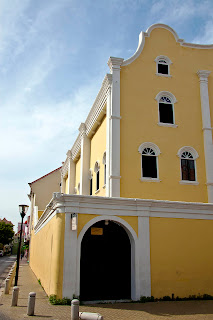Willemstad is a big town, but easily walkable. The city is divided by Sint Annabaai channel, a waterway which leads to the largest natural harbor, now used primarily for petroleum refining and a large shipping port. The oldest section of town, Punda, has buildings dating from the mid-1600s, including Fort Amsterdam which now houses the government. The later buildings from the 1700s illustrate what has become known as the Dutch Caribbean style where the facades are painted pastel colors to eliminate glare from the sun. The city really is an architectural historian’s paradise. There is also a colorful floating market where Venezuelan merchants offer produce and souvenirs.
In the heart of Punda is the synagogue, built in 1732. It is the home of an active Sephardic congregation, Mikve Israel-Emanuel. The temple is a large building within a walled courtyard and has a sand floor, the tradition recalling the days of the inquisition and the conversos. We contacted the synagogue and were able to attend during Yom Kippur. The services were mostly conducted in English and Hebrew, though during aliyahs, some of chanting was in Ladino, the language of the Sephardim.

































